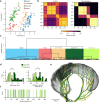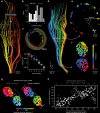Three-dimensional architecture and linearized mapping of vibrissa follicle afferents
- PMID: 39779697
- PMCID: PMC11711312
- DOI: 10.1038/s41467-024-55468-4
Three-dimensional architecture and linearized mapping of vibrissa follicle afferents
Abstract
Understanding vibrissal transduction has advanced by serial sectioning and identified afferent recordings, but afferent mapping onto the complex, encapsulated follicle remains unclear. Here, we reveal male rat C2 vibrissa follicle innervation through synchrotron X-ray phase contrast tomograms. Morphological analysis identified 5% superficial, ~32 % unmyelinated and 63% myelinated deep vibrissal nerve axons. Myelinated afferents consist of each one third Merkel and club-like, and one sixth Ruffini-like and lanceolate endings. Unsupervised clustering of afferent properties aligns with classic morphological categories and revealed previously unrecognized club-like afferent subtypes distinct in axon diameter and Ranvier internode distance. Myelination and axon diameters indicate a proximal-to-distal axon-velocity gradient along the follicle. Axons innervate preferentially dorso-caudally to the vibrissa, presumably to sample contacts from vibrissa protraction. Afferents organize in axon-arms innervating discrete angular territories. The radial axon-arm arrangement around the vibrissa maps into a linear representation of axon-arm bands in the nerve. Such follicle linearization presumably instructs downstream linear brainstem barrelettes. Synchrotron imaging provides a synopsis of afferents and mechanotransductory machinery.
© 2025. The Author(s).
Conflict of interest statement
Competing interests: The authors declare no competing interests.
Figures






Similar articles
-
Follicle architecture and innervation of functionally distinct rat vibrissae.Commun Biol. 2025 Jul 1;8(1):979. doi: 10.1038/s42003-025-08336-w. Commun Biol. 2025. PMID: 40596464 Free PMC article.
-
Sensory innervation in the inner conical body of the vibrissal follicle-sinus complex of the rat.J Comp Neurol. 1993 Feb 8;328(2):232-51. doi: 10.1002/cne.903280206. J Comp Neurol. 1993. PMID: 8423242
-
Changes in the axon terminals of primary afferents from a single vibrissa in the rat trigeminal nuclei after active touch deprivation or exposure to an enriched environment.Brain Struct Funct. 2018 Jan;223(1):47-61. doi: 10.1007/s00429-017-1472-5. Epub 2017 Jul 12. Brain Struct Funct. 2018. PMID: 28702736
-
Similarities and differences in the innervation of mystacial vibrissal follicle-sinus complexes in the rat and cat: a confocal microscopic study.J Comp Neurol. 2002 Jul 22;449(2):103-19. doi: 10.1002/cne.10277. J Comp Neurol. 2002. PMID: 12115682
-
Structure-function relationships in rat medullary and cervical dorsal horns. I. Trigeminal primary afferents.J Neurophysiol. 1986 Jun;55(6):1153-86. doi: 10.1152/jn.1986.55.6.1153. J Neurophysiol. 1986. PMID: 3734853
Cited by
-
Traditions of Excellence: neuroanatomy at the forefront of the new era.Anat Sci Int. 2025 May 22. doi: 10.1007/s12565-025-00852-3. Online ahead of print. Anat Sci Int. 2025. PMID: 40402345 Review.
-
Follicle architecture and innervation of functionally distinct rat vibrissae.Commun Biol. 2025 Jul 1;8(1):979. doi: 10.1038/s42003-025-08336-w. Commun Biol. 2025. PMID: 40596464 Free PMC article.
References
-
- Maderson, P. F. When? Why? and How? Some speculations on the evolution of the vertebrate integument. Am. Zool.12, 159–171 (1972).
-
- Brecht, M., Preilowski, B. & Merzenich, M. M. Functional architecture of the mystacial vibrissae. Behav. Brain Res84, 81–97 (1997). - PubMed
-
- Wolfe, J., Mende, C. & Brecht, M. Social facial touch in rats. Behav. Neurosci.125, 900–910 (2011). - PubMed
MeSH terms
Grants and funding
LinkOut - more resources
Full Text Sources
Miscellaneous

